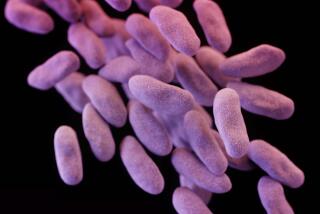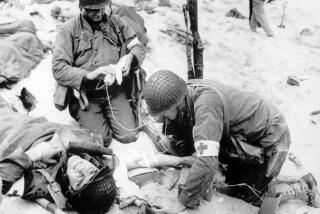Amid Frantic AIDS Cure Search, Wonder Drug Discoveries Fade : Medicine: It’s easy to take antibiotics for granted, but the tens of millions of people they have rescued worldwide is also beyond estimate.
- Share via
BETHESDA, Md. — In the last 50 years, millions of Americans have survived infectious diseases that would have killed them in the 50 years before that.
No one knows for certain just how many lives have been saved, but broad-spectrum antibiotics rescued the world from the insidious and fatal bacterial infections that haunted mankind through the millennia.
Imagine the world before antibiotics, when chance colds could turn to deadly pneumonia, when tuberculosis struck down the rich and poor, when an accidental cut would invite an infection that spread through the body as fast as the bacteria could reproduce, when a wounded soldier would die not of the bullet but of the infected wound.
Nearly every family lost someone because scientific luck came a little late.
And when it came, how natural it was to name the rainbow of antibiotics it spawned: The Wonder Drugs.
This is the century of The Wonder Drugs.
How many millions of American children are alive at the closing of the 20th Century because there was a sulfanilamide, a penicillin, a streptomycin or tetracycline or any of the myriad antibiotics wrung from the microorganisms of the soil?
How many tens of millions of people were rescued around the world is also beyond estimate. But a footnote might help: This winter it is predicted that thousands may perish in the Soviet Union alone for lack of the ability to buy antibiotics.
The world’s attention quickly turned from antibiotics in the late ‘50s to the viral diseases and vaccines that could eradicate them, diseases such as polio and smallpox and measles that were untouched by antibiotics. And now the new nemesis, the virus that causes AIDS.
But the first heroes on the scene became a metaphor for the 20th Century. They were the antibiotics that later set the stage for daring advances in surgery by barring the door to the ubiquitous and lethal bacterial killers.
Before the turn of the century, the specter of “The White Plague,” tuberculosis, hung over the cities of Western Europe and the new cities of the United States. That fear was woven into the culture. In the operas “La Traviata” and “La Boheme” the heroines died in its tragic grip.
Tuberculosis became a thief robbing Western culture. It took the lives of Anton Chekhov in 1904, Franz Kafka in 1924, D.H. Lawrence in 1930, George Orwell in 1950. And before that Chopin, Robert Louis Stevenson, Heinrich Heine, John Keats.
The year Kafka died, Thomas Mann’s masterpiece, “The Magic Mountain,” was published . It was the story of a tuberculosis sanitarium on a mountaintop much like the one where his wife languished with tuberculosis.
The sanitariums’ clear, dry air plus rest and good nutrition were the prescribed treatments before streptomycin. People with “weak chests” sought “the cure” in the desert quiet of the Southwest or serene locales like Saranac Lake, N.Y., which for 70 years was known as “the city of the sick.” Today the old sanitariums, including the Will Rogers Hospital, have been converted to condominiums, a conference center and a state prison.
But the old killers are still out there, the streptococci, staphylococci, the bacterial pneumonias, syphilis, gonorrhea, the bacteria that attack the heart, the dozens of opportunistic microbes. They are held at bay only by better sanitation and the still growing armament of antibiotics.
So common are the Wonder Drugs now that much of today’s world takes them for granted. Indeed, tuberculosis is coming back for two reasons: The poor and homeless go untreated, and among the more affluent with respiratory ills, doctors frequently overlook the possibility because they haven’t seen TB cases in years.
Medicine by habit tends to look forward. Although it would be possible to crunch the numbers from mortality figures, apparently no one has done it.
One researcher in 1958 estimated that 1.5 million Americans had been spared death in the 10 to 15 years preceding penicillin’s arrival in 1945. Life expectancy for Americans at birth was 63 when sulfa drugs became available in the 1930s and 65 when penicillin came on the scene in the mid-century. By 1978 it was 72. Today it is 74 1/2.
The death rate from syphilis was 300 per 100,000 when penicillin was first used for the population at large. By 1978 it had dropped to 25 per 100,000. In England and Wales the death toll from streptococcal childbed fever dropped by a factor of 100 with the advent of the sulfas and the penicillins.
Dr. Gladys Hobby says in her book “Penicillin”: “Not only did it decrease the incidence and severity of many infectious diseases . . . it made possible cardiac surgery, organ transplantation and the management of severe burns.”
The discovery of the antibiotics is a wonderment in itself. It began with the concepts of antibiosis and immunology that were born in the 19th Century from the minds of Louis Pasteur and Paul Ehrlich.
Then, in the World War II era, the story began to unfold, punctuated by the death of a London police officer who cut himself shaving and a moldy cantaloupe in a fruit stand in Peoria, Ill.
“Man’s discovery of antimicrobial agents,” as one scientific historian said, “must surely rank as one of his greatest triumphs.”
Dr. John Parascandola, chief of the History of Medicine for the National Library of Medicine in Bethesda, says, “penicillin opened the door to all kinds of things.” He recently wrote:
“While other writers on the history of medicine might dispute the choice of antibiotics as the most significant medical advance in all of history, it would probably be difficult to identify a class of therapeutic agents which has had a greater impact on human health.”
In the history of science probably no stroke of luck is better known than that of Alexander Fleming’s chance discovery in 1928 that one of his bacterial culture plates was contaminated by Penicillium mold, similar to the blue-green mold that grows on old bread. It was probably airborne from a neighboring laboratory at St. Mary’s Hospital, London, while he was off on holiday. He was going to throw the tainted culture away when he discovered that the bacteria on the glass plate was not growing around the mold.
The next year he published a paper. He had proved that the substance he called penicillin was safe for laboratory animals but it was devastating to certain bacteria, even in the meager, impure doses he eked out of his mold sample. Maybe, he thought with cautious optimism, it might be useful as an antiseptic applied externally.
He passed out samples of the mold to other researchers. But the few attempts to isolate the active element from the mold juice or to use it clinically came to naught.
Enter Howard Florey, an Australian-born pathologist, and Ernst Chain, a young Jewish biochemist who had fled the Nazis. Working at Oxford University, they were fascinated by some of Fleming’s other work in which he found that there was a substance in his own nasal secretions that killed a new bacterium he had discovered. He isolated an enzyme called lysozyme, which was also present in tears and saliva.
But while the enzyme broke down the cell walls of some bacteria, it was powerless against the more common and deadly ones, such as the strep and staph infections that were rampant in the world.
Florey and Chain came across Fleming’s old paper on penicillin and obtained samples of the mold, which they proceeded to grow. Then in 1939, as Europe was exploding in war, another scientist, Rene Dubos, spurred the search for antibiotics by discovering substances in soil bacteria that could attack other organisms. Further research showed them to be too toxic for humans, but it stimulated new research by Dubos’ former teacher, Selman Waksman.
“Actually,” says Parascandola, “penicillin was so much more effective as an antibacterial agent than any other drug known at the time, including the then-recently introduced sulfonamides, that the Oxford team at first greatly underestimated its potency.”
So primitive were their resources, they had to invent as they went along, Parascandola says, including the process of freeze-drying, which allowed them to produce a crude brown powder. “What they had was really only 1% penicillin and the rest impurities. Fortunately the impurities were not toxic.”
They began to increase their production of penicillin, which the mold yielded in scant quantities. They produced it in triangular flasks, which was a great waste of space since the mold grew only on the surface of a shallow pool of nutrient. They experimented with everything, including hospital bedpans, but materials were short in wartime Britain. They finally had a ceramic manufacturer construct some rectangular basins, which could be stacked. But still production was slight.
Joined by Norman Heatley and E. P. Abraham, they began to try their short supplies on human volunteers. The first was a terminal cancer patient, not to treat the cancer, but to test the toxicity of the drug. It was safe. Then they tried it on a terminally ill policeman who was near death from both staph and strep infections, which had developed after he had cut himself while shaving. The policeman made a striking recovery until the supply of penicillin ran out. He relapsed and died.
Even before Florey’s human tests, physicians at New York’s Presbyterian Hospital tried it on a bacterial heart infection to no avail. Reported to a scientific meeting and then through the press, it stirred considerable interest.
Florey decided that future tests would have to be made on children who required smaller doses. He also knew he would need much more penicillin.
But Britain was fighting off the Germans. Experimental drugs had low priority.
The summer of 1941, Florey and Heatley took their search for support to the United States. They were directed to the Northern Regional Research Laboratory of the Department of Agriculture in Peoria. Scientists there were experienced in fermentation as part of their effort to find new products and markets for American farmers. They were delighted to find that corn steep liquor, a practically useless agricultural byproduct, was an ideal nutrient for the mold.
They devised ways of growing the Penicillium mold in huge fermentation vats where they could feed in oxygen and churn the hundreds of gallons of nutrient and mold, thereby greatly increasing the growing area and the penicillin production.
They also began to sift through thousands of Penicillium molds gathered from all over the world to find one that might produce more penicillin than Fleming’s.
“The one that turned out to be the most productive,” Parascandola says, “was one they found growing on a moldy cantaloupe in a Peoria fruit market. . . .
“Over the years they improved that strain by producing mutations with ultraviolet radiation or chemicals. But I think even today the penicillin that is produced is derived from that moldy cantaloupe.”
The U.S. War Production Board set up a cooperative penicillin project involving about 20 laboratories. Word got around and the demand for the wonder drug spread, even to people with cancer. But the military had priority, and it wasn’t until 1945 that supplies were ample and restrictions were relaxed. Before that, a civilian’s doctor had to apply for dosage and had to show that another drug, such as sulfa, would not suffice.
The sulfa drugs carried the burden of fighting infections early in the war. That was ironically a German discovery. Scientists at the old Bayer Co., then a part of I.G. Farben, the German chemical cartel, synthesized a dye called prontosil and chemotherapist Gerhard Domagk conducted detailed experiments against various pathogenic bacteria, including strep infections.
By 1939, the various sulfonamides were established in the medical treatment of bacterial infections, the first chemical since Paul Ehrlich’s Salvarsan, an arsenic compound dubbed The Magic Bullet because of its ability to attack the spirochete that causes syphilis and the protozoan trypanosomes that cause sleeping sickness. Ehrlich won a Nobel Prize and almost two of them for his work in antibiosis. Domagk won one for his discovery of sulfa, although the Nazis would not let him receive it.
While the United States was pressing penicillin production, soil microbiologist Selman Waksman headed one of the most active antibiotics laboratories in the United States at Rutgers University in New Brunswick, N.J. In 1940, Waksman isolated actinomycin from organisms that resemble bacteria and fungi, called actinomycetes. It was the forerunner of some of the most effective antibiotics of the era.
Then in 1943 he produced streptomycin, which proved useful against the tuberculosis bacillus. A host of other soil-derived antibiotics followed, chloramphenicol in 1947, chlortetracycline in 1948, and oxytetracycline in 1950, many of them the result of hundreds of soil samples from around the world.
Antibiotics have been effective against everything from pneumococcal pneumonia to meningococcal meningitis, from diphtheria to Rocky Mountain spotted fever.
But the wonder drugs have limitations. Certain microorganisms develop an immunity to these compounds by producing enzymes that inactivate them. Broader spectrum antibiotics now emerging are self-limiting simply because they kill off too many bugs and produce bacterial instabilities in the body.
Yet no one can question their impact. When Fleming was born in 1881, life expectancy was only 54. When he died in 1955, people born that year could expect to live to almost 70.






